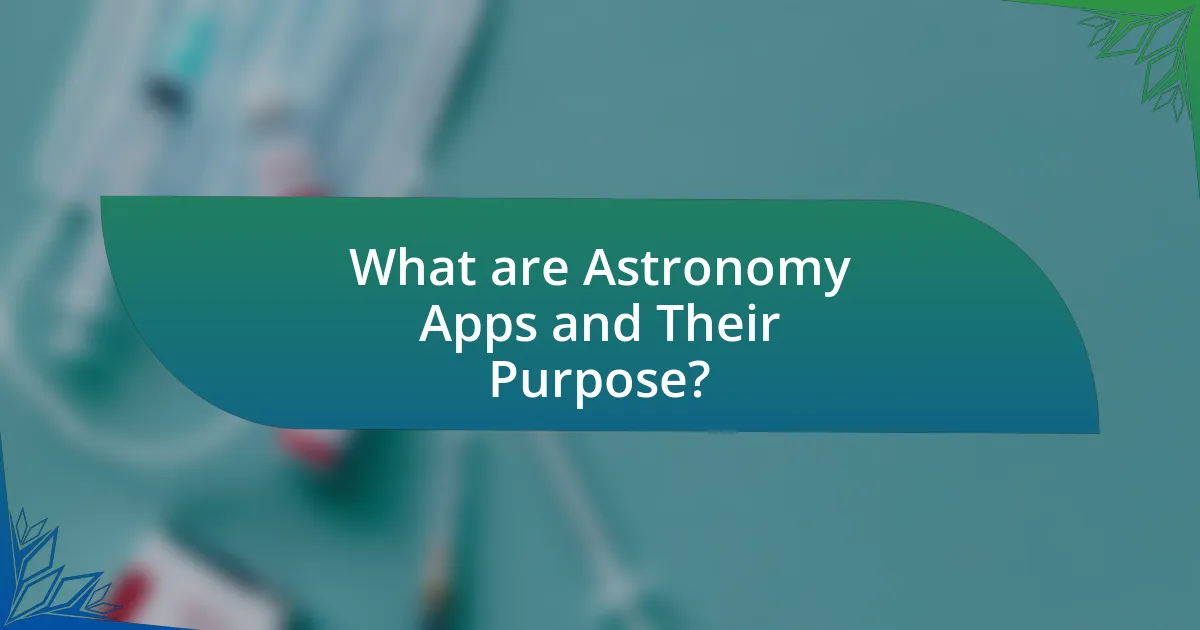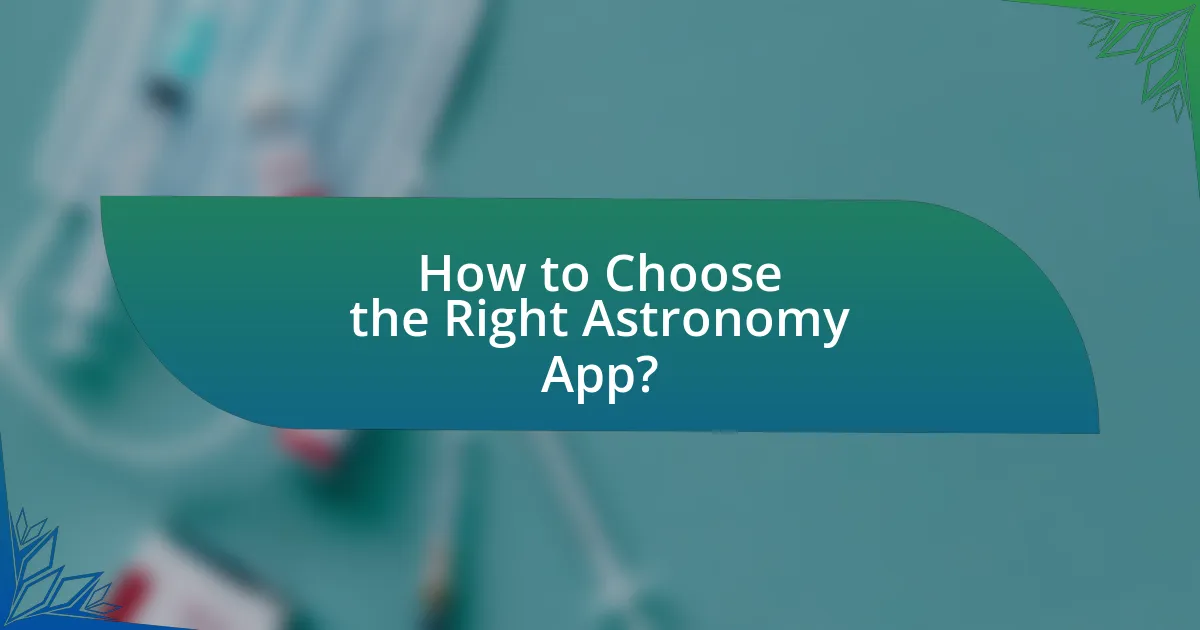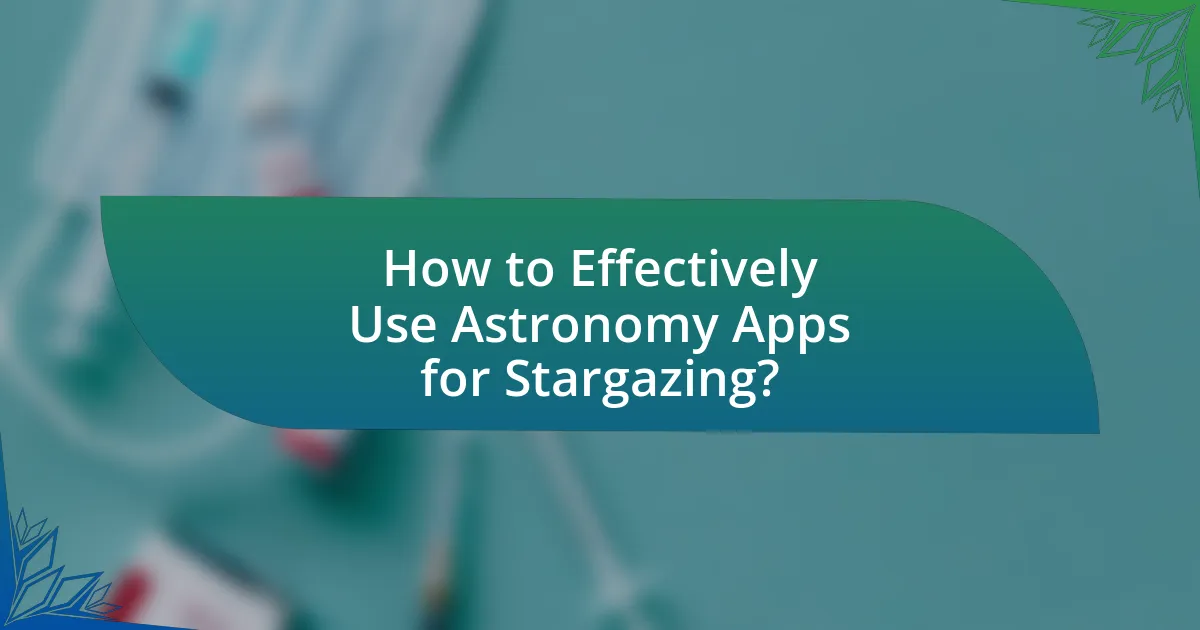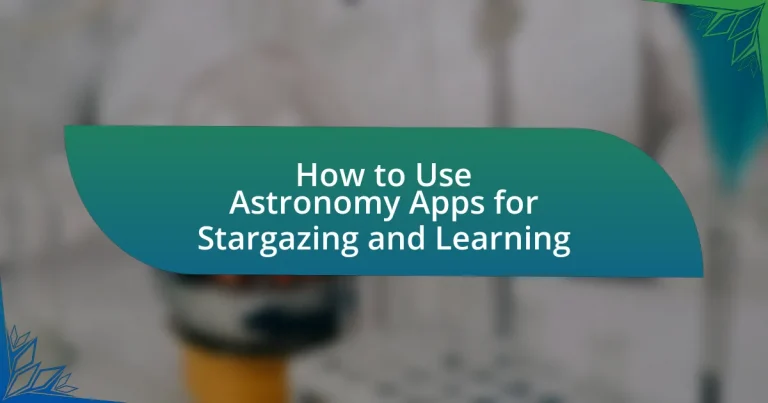Astronomy apps are mobile applications designed to enhance the stargazing experience by providing real-time information about celestial objects and phenomena. They utilize augmented reality, GPS, and compass technology to help users identify stars, planets, and constellations while offering educational content and notifications for celestial events. The article explores the features and benefits of astronomy apps, their importance for amateur astronomers, and how to effectively use them for learning and tracking celestial events. It also discusses factors to consider when selecting an app, best practices for stargazing, and troubleshooting tips to optimize the user experience.

What are Astronomy Apps and Their Purpose?
Astronomy apps are mobile applications designed to assist users in exploring celestial objects and phenomena. Their primary purpose is to provide information about stars, planets, constellations, and other astronomical features, often using augmented reality to enhance the user experience. For instance, many astronomy apps utilize GPS and compass technology to identify and display the night sky in real-time, allowing users to point their devices at the sky and receive instant information about what they are viewing. This functionality is supported by databases that include detailed descriptions, images, and historical data about celestial bodies, making astronomy more accessible and engaging for both amateur stargazers and seasoned astronomers.
How do Astronomy Apps enhance stargazing experiences?
Astronomy apps enhance stargazing experiences by providing real-time information about celestial objects and events. These applications utilize augmented reality to overlay constellations, planets, and stars onto the night sky, allowing users to easily identify and learn about them. For instance, apps like SkySafari and Star Walk 2 offer detailed descriptions, images, and historical context for various astronomical phenomena, enriching the user’s understanding and engagement. Additionally, features such as notifications for upcoming celestial events, like meteor showers or eclipses, ensure that users do not miss significant occurrences, thereby maximizing their stargazing enjoyment.
What features do Astronomy Apps typically offer for stargazers?
Astronomy apps typically offer features such as star maps, augmented reality (AR) overlays, celestial event notifications, and detailed information about celestial objects. Star maps allow users to identify stars, planets, and constellations in real-time by pointing their devices at the sky. Augmented reality overlays enhance the stargazing experience by superimposing digital information onto the real-world view. Celestial event notifications keep users informed about upcoming astronomical events like meteor showers or eclipses. Additionally, these apps often provide educational content, including articles and images, to enhance learning about astronomy.
How do these features improve learning about celestial objects?
Features in astronomy apps enhance learning about celestial objects by providing interactive visualizations and real-time data. These tools allow users to explore the night sky, identify stars, planets, and constellations, and access detailed information about each object. For instance, augmented reality features enable users to point their devices at the sky and receive instant feedback on celestial bodies, fostering a deeper understanding of their positions and movements. Additionally, educational content, such as articles and videos, enriches the learning experience by offering context and historical significance, making the study of celestial objects more engaging and informative.
Why are Astronomy Apps important for amateur astronomers?
Astronomy apps are important for amateur astronomers because they provide essential tools for identifying celestial objects and enhancing the stargazing experience. These applications utilize augmented reality and real-time data to help users locate stars, planets, and constellations, making astronomy more accessible and engaging. For instance, apps like SkySafari and Star Walk offer interactive star maps and detailed information about astronomical events, which can significantly improve observational skills and knowledge. Additionally, studies have shown that the use of mobile technology in astronomy education increases interest and participation among amateur astronomers, as it allows for immediate access to information and resources while observing the night sky.
What role do Astronomy Apps play in making astronomy accessible?
Astronomy apps play a crucial role in making astronomy accessible by providing users with interactive tools that simplify the identification of celestial objects and enhance learning experiences. These applications often utilize augmented reality, allowing users to point their devices at the night sky and receive real-time information about stars, planets, and constellations. For instance, apps like SkySafari and Star Walk have been shown to increase engagement and understanding of astronomical concepts among users, as they offer detailed descriptions, images, and educational content. Furthermore, studies indicate that mobile technology has significantly lowered barriers to entry for amateur astronomers, enabling a broader audience to explore and appreciate the universe.
How can Astronomy Apps foster a community of stargazers?
Astronomy apps can foster a community of stargazers by providing platforms for users to share observations, experiences, and knowledge. These apps often include features such as social networking, where users can connect with others, share images of celestial events, and discuss findings in real-time. For instance, apps like SkySafari and Star Walk allow users to post their stargazing experiences and engage in discussions, creating a sense of belonging among enthusiasts. Additionally, many astronomy apps offer event notifications for meteor showers, eclipses, and other astronomical phenomena, encouraging users to gather and observe together, thus strengthening community ties.

How to Choose the Right Astronomy App?
To choose the right astronomy app, evaluate your specific needs, such as whether you want to identify stars, track celestial events, or learn about constellations. Consider features like augmented reality, user interface, and compatibility with your device. Research user reviews and ratings to gauge the app’s effectiveness and reliability. For instance, apps like SkySafari and Star Walk 2 are highly rated for their comprehensive databases and user-friendly designs, making them suitable for both beginners and experienced astronomers.
What factors should you consider when selecting an Astronomy App?
When selecting an Astronomy App, consider the app’s features, user interface, compatibility, and community support. Features such as star maps, augmented reality, and educational content enhance the stargazing experience. A user-friendly interface ensures ease of navigation, while compatibility with various devices, including smartphones and tablets, is crucial for accessibility. Community support, including forums and user reviews, provides insights into the app’s reliability and effectiveness. Research indicates that apps with strong community engagement often lead to higher user satisfaction and retention rates.
How do user reviews influence the choice of an Astronomy App?
User reviews significantly influence the choice of an Astronomy App by providing potential users with insights into the app’s functionality, usability, and overall satisfaction. Research indicates that 79% of consumers trust online reviews as much as personal recommendations, highlighting the importance of user feedback in decision-making processes. Positive reviews can enhance an app’s credibility and attract more downloads, while negative reviews can deter users, as they often detail specific issues such as bugs, lack of features, or poor customer support. Furthermore, apps with higher ratings and favorable reviews tend to rank better in app store search results, making them more visible to potential users.
What are the differences between free and paid Astronomy Apps?
Free astronomy apps typically offer basic features such as star maps, constellation identification, and limited educational content, while paid astronomy apps provide advanced functionalities like augmented reality, detailed celestial event notifications, and extensive databases of astronomical objects. For instance, free apps may limit the number of stars or planets displayed, whereas paid versions often include high-resolution images and in-depth information about celestial phenomena. Additionally, paid apps frequently receive regular updates and customer support, enhancing user experience and learning opportunities.
Which features are essential in a good Astronomy App?
A good Astronomy App must include features such as real-time sky mapping, celestial object identification, and educational content. Real-time sky mapping allows users to visualize the night sky based on their location and time, enhancing the stargazing experience. Celestial object identification helps users recognize stars, planets, and constellations through augmented reality or interactive guides. Educational content, including articles, videos, and quizzes, enriches the learning experience by providing context and information about astronomical phenomena. These features collectively improve user engagement and knowledge retention in astronomy.
How does augmented reality enhance the stargazing experience?
Augmented reality enhances the stargazing experience by overlaying digital information onto the real night sky, allowing users to identify celestial objects more easily. This technology utilizes smartphone cameras and sensors to provide real-time data about stars, planets, and constellations, making it accessible for both novice and experienced stargazers. For example, apps like SkyView and Star Walk use augmented reality to display the names and details of celestial bodies directly in the user’s line of sight, improving engagement and understanding of astronomical phenomena.
What tools for tracking celestial events should be included?
Tools for tracking celestial events should include astronomy apps, telescopes, and star charts. Astronomy apps like SkySafari and Star Walk provide real-time tracking of celestial bodies and events, allowing users to identify stars, planets, and constellations easily. Telescopes, such as the Celestron NexStar series, enable detailed observation of celestial phenomena, including eclipses and planetary transits. Star charts, both physical and digital, serve as guides for locating celestial events and understanding their timing and significance. These tools collectively enhance the stargazing experience by providing accurate information and facilitating deeper learning about the universe.

How to Effectively Use Astronomy Apps for Stargazing?
To effectively use astronomy apps for stargazing, first, select a reliable app that provides real-time sky maps and celestial object information. Popular apps like SkySafari and Star Walk 2 utilize augmented reality to overlay constellations and planets onto your device’s camera view, enhancing the stargazing experience.
Next, ensure your device’s location services are enabled, allowing the app to accurately display the night sky based on your geographical position. Many astronomy apps also offer features such as notifications for celestial events, which can help you plan your stargazing sessions around meteor showers or planetary alignments.
Additionally, familiarize yourself with the app’s interface and tools, such as zoom functions and filters for different types of celestial objects. This knowledge will enhance your ability to identify stars, planets, and constellations effectively.
Lastly, consider using the app in a dark location away from city lights to improve visibility and accuracy. Research indicates that light pollution significantly affects stargazing quality, making dark-sky locations ideal for optimal viewing experiences.
What are the best practices for using Astronomy Apps during stargazing?
The best practices for using Astronomy Apps during stargazing include ensuring proper device settings, selecting appropriate apps, and utilizing features effectively. First, users should adjust their device settings to minimize light pollution by enabling night mode or reducing screen brightness, which helps preserve night vision. Second, choosing reputable astronomy apps, such as SkySafari or Star Walk, enhances the stargazing experience by providing accurate star maps and celestial information. Third, utilizing features like augmented reality and real-time tracking allows users to identify constellations and celestial objects more easily. These practices enhance the overall stargazing experience by improving visibility and understanding of the night sky.
How can you optimize your location settings for accurate results?
To optimize your location settings for accurate results in astronomy apps, ensure that your device’s GPS is enabled and set to high accuracy mode. High accuracy mode utilizes GPS, Wi-Fi, and mobile networks to determine your location more precisely, which is crucial for stargazing applications that rely on exact coordinates. Additionally, regularly calibrate your compass and ensure that your device’s location services are updated to reflect any changes in your environment. Accurate location settings enhance the app’s ability to provide relevant celestial information based on your specific geographic position, improving your overall stargazing experience.
What tips can help you identify stars and constellations using the app?
To identify stars and constellations using an astronomy app, utilize the app’s augmented reality feature, which overlays star maps onto the night sky. This feature allows users to point their device at the sky and see real-time information about celestial objects. Additionally, ensure location services are enabled for accurate positioning, as this helps the app provide relevant star and constellation data based on your geographical location. Many apps also offer guided tours or tutorials that can enhance your understanding of the night sky, making it easier to recognize patterns and specific stars.
How can you integrate Astronomy Apps into your learning process?
Integrating Astronomy Apps into your learning process can be achieved by using them to enhance your understanding of celestial objects and phenomena. These apps provide interactive features such as augmented reality, real-time tracking of stars and planets, and educational content that can deepen your knowledge of astronomy. For example, apps like SkySafari and Star Walk allow users to point their devices at the sky to identify constellations and planets, facilitating hands-on learning. Research indicates that interactive learning tools significantly improve retention and engagement, making astronomy apps effective educational resources.
What educational resources do Astronomy Apps provide for users?
Astronomy apps provide users with a variety of educational resources, including interactive star maps, detailed information about celestial objects, and guided tours of the night sky. These resources enhance learning by allowing users to identify stars, planets, and constellations in real-time, often using augmented reality features. For instance, many apps offer extensive databases that include facts about the history, composition, and significance of astronomical bodies, which can deepen users’ understanding of the universe. Additionally, some apps feature quizzes and challenges that promote engagement and reinforce learning through interactive experiences.
How can you use Astronomy Apps to track your learning progress?
You can use Astronomy Apps to track your learning progress by utilizing features such as quizzes, progress tracking metrics, and personalized learning paths. Many astronomy apps offer built-in quizzes that assess your knowledge on various topics, allowing you to identify areas for improvement. Additionally, these apps often include progress tracking metrics that visually represent your learning journey, showing how many topics you’ve covered and your mastery level in each. Personalized learning paths adapt to your interests and knowledge level, ensuring that you are continually challenged and engaged. For example, apps like SkySafari and Star Walk provide these functionalities, enabling users to monitor their understanding of celestial objects and astronomical concepts effectively.
What troubleshooting tips can enhance your experience with Astronomy Apps?
To enhance your experience with Astronomy Apps, ensure that your device’s location services are enabled for accurate star mapping. This allows the app to provide real-time data based on your geographical position, which is crucial for stargazing. Additionally, regularly update the app to access the latest features and bug fixes, as developers frequently release updates to improve performance and user experience. Clear the app’s cache if it becomes unresponsive, as this can resolve issues related to slow performance or crashes. Lastly, consult the app’s help section or user forums for specific troubleshooting advice tailored to your app, as community insights can often provide effective solutions to common problems.
How do you resolve common issues with app functionality?
To resolve common issues with app functionality, first, identify the specific problem, such as crashes, slow performance, or incorrect data display. Next, implement troubleshooting steps like restarting the app, clearing the cache, or updating to the latest version, as these actions often rectify functionality issues. For instance, a study by the Nielsen Norman Group indicates that 70% of app users experience improved performance after clearing the cache. Additionally, consulting the app’s support documentation or community forums can provide targeted solutions based on user experiences.
What steps can you take if the app fails to recognize celestial objects?
If the app fails to recognize celestial objects, first ensure that the device’s location services are enabled and set to high accuracy. This is crucial because accurate location data allows the app to align with the night sky correctly. Next, check that the app has the latest updates installed, as updates often include bug fixes and improved recognition algorithms. Additionally, verify that the device’s camera lens is clean and unobstructed, as obstructions can hinder object recognition. If issues persist, consult the app’s help section or user forums for troubleshooting tips specific to the app in use. These steps are essential for enhancing the app’s performance and ensuring accurate celestial object identification.




